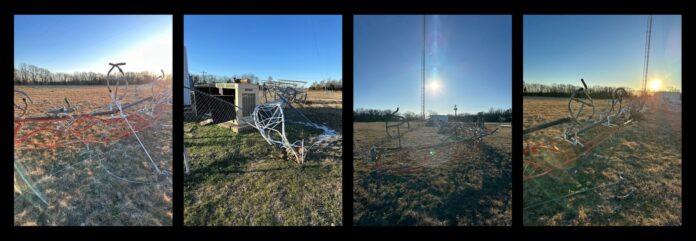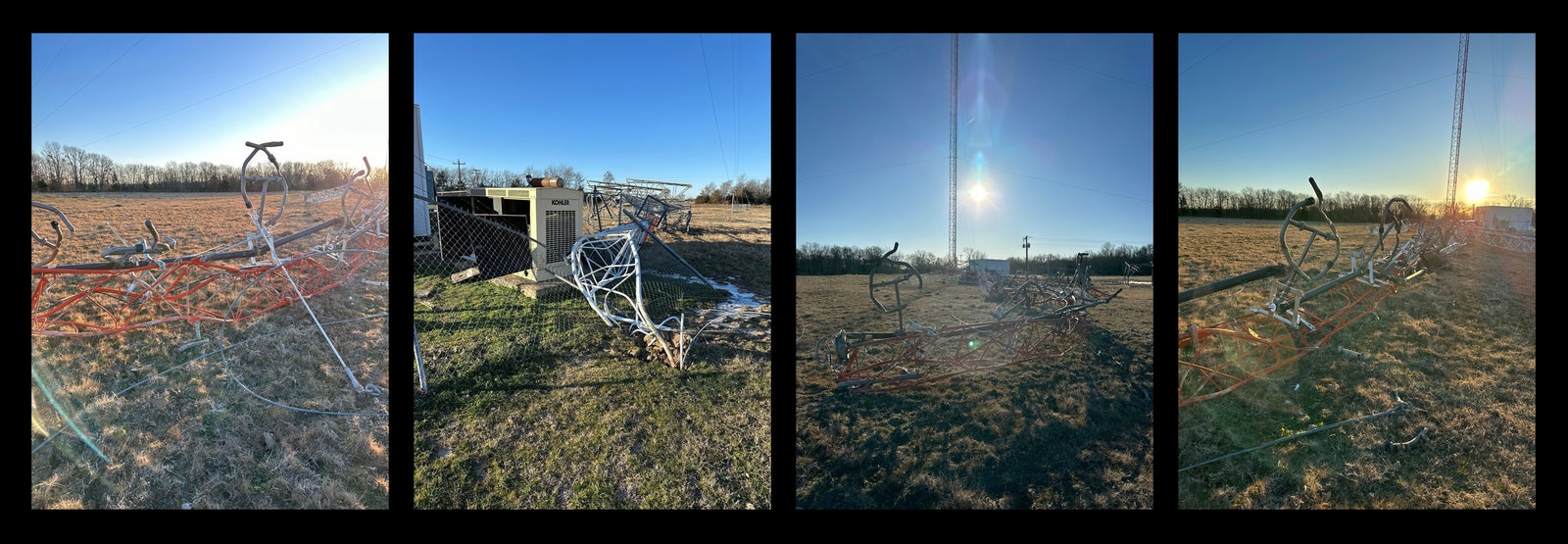Something had gone wrong with the giant radio tower. Will Payne, of Payne Media Group, got an alert from his utility company in the middle of the night telling him as much. But it wasn’t until he got to the site around 5am, in subzero temperatures, that he realized what had happened.
The tower in question, a 499-foot mast in the middle of a field in Hugo, Oklahoma, was almost as tall as the UN building in New York. It broadcast K95.5—a radio station for Oklahoma and Texas that plays “Continuous Country.”
When Payne pulled up it was still pitch black outside, but the headlights on his truck picked out something on the ground.
He couldn’t believe it. The top half of the tower was lying in tatters, a crumpled mess of white and red painted steel. Payne could also see that the small building at the base of the tower had been broken into. He backed his truck out and called the cops.
“It’s your worst nightmare,” says Payne, who later that morning inspected the ruins, discovering that meters and meters of inches-thick coaxial copper cable had apparently been stolen from the stricken mast, ripped out with power tools. “I built this tower in 2017, and so, to me, it’s brand new. It’s just heart-breaking.”
Metal theft is on the rise, largely linked to soaring commodity prices. Copper is roughly 30 percent more expensive than it was five years ago, for example, while steel spiked 200 percent during the pandemic, though prices have settled down significantly in the last two years. As such, thieves have taken to swiping everything from drain covers to miles of copper cabling. The conduits that keep people connected, the infrastructure that civilization depends on—it’s all fair game for a metal bandit. The disruption caused is often totally disproportionate to the face value of the stolen material.
As the world electrifies, and as we depend more and more on machinery packed with copper, steel, and precious metals, this form of theft is getting ever more serious. Meanwhile, victims are left wondering—isn’t there any way to stop it?
Metal theft is certainly not new. For instance, historians surmise that as well as gold and precious stones, ancient thieves stole metal razor blades from the tomb of the Egyptian pharaoh Tutankhamun. These implements were possibly melted down and traded.
Because our lives are so utterly dependent on metal infrastructure, thefts are arguably more damaging than ever today. Earlier this month, metal thieves struck the German railway system, temporarily “paralyzing” it.
In India, there have been reports of a 1 km stretch of metal fencing being stolen from a major highway, and an entire bridge was allegedly stolen in 2022. Cable theft on the transit network in South Africa is so prolific that academics are writing papers about how it has affected the free flow of traffic in the country. And some thieves are even stealing metal plaques from gravestones in cemeteries—this has happened both in the UK and the US.
K95.5 was off-air for more than a week, until Payne could get an antenna secured to the part of the tower left standing. They’re still only broadcasting at half-power, he says. It appears the thieves cut the lengthy guy wires that fastened the tower to the ground, destabilizing it so that it toppled. They then allegedly harvested copper from the fallen section. Payne estimates repairs will cost half a million dollars, if not more.
Two people have been arrested in the case, a man and a woman who were reported selling copper cabling matching that from the tower at a scrap yard in neighbouring Texas. Choctaw County Sheriff Terry Park, who spoke to WIRED, says the investigation is ongoing.
It’s far from the only incident like it. Just a few weeks later, thieves targeted a smaller, 200-foot radio tower in Alabama. In that case, they took the entire structure away, leaving the radio station owners bewildered.
“These are not unique stories, as unbelievable as it is,” says Ben Stickle, a metal theft expert and researcher, who has studied large-scale metal thefts and their impacts. He remembers what he was doing when he first realized how sought-after metal can be. Several years ago, he was rolling an old, rusting water tank down his street—it was to be collected as rubbish. But a guy driving by stopped in the middle of the road and said: “Hey, are you gonna throw that away?” Soon, Stickle found himself helping to cram the filthy tank into the back of the man’s small car. “He takes off down the street. I’m standing there going: ‘What just happened?’” recalls Stickle.
His latest paper, accepted but not yet published, studies thefts of catalytic converters in California. These devices, which scrub toxic gases and pollutants from vehicle exhausts, are often targeted because they contain precious metals including palladium and platinum. By studying metal prices and reports of converters going missing, including on the Nextdoor social network, Stickle and his coauthors estimate that, for every 10 percent rise in metal prices, there’s a 20 percent uptick in thefts of these devices.
Some people will go to extraordinary lengths to harvest metal. For his 2017 book on the subject, Metal Scrappers and Thieves: Scavenging for Survival and Profit, Stickle interviewed one man who used to hunt down abandoned buildings on Google, then find pictures or videos from urban explorers who had visited these locations for kicks, just to see if he could spot any copper in their footage. If he did, he’d drive over and start plundering. “He might spend a week stealing the metal out of it,” says Stickle.
With the electrification of vehicles, heating systems, and other infrastructure, Stickle says thieves are only going to have more and more targets to choose from in the future. Last year, a resident of Los Angeles said they captured footage of a masked individual removing a copper-rich EV charging cable from their driveway.
Law enforcers are increasingly concerned about the scale of metal thefts. In the UK in January, a group of Members of Parliament (MPs) published a report on rising levels of metal theft over the last five years. Official figures indicate that cases of metal theft in England and Wales have almost doubled, from around 17,500 in 2020 to 28,500 in 2023. Organized crime is driving the trend, the MPs’ report concluded.
“There is work being done, I just think that, for us, one of the biggest issues is the lack of enforcement of the Scrap Metal Dealers Act,” says Antonia Grey of the British Metals Recycling Association.
That 2013 Act came into force following an earlier spike in thefts, which was also associated with high metal prices at the time. It requires metal dealers to obtain a licence and ensure that they verify the identity of scrap metal sellers, among other measures. The Act coincided with a police intervention to enforce it called Operation Tornado, which has since been credited with cutting metal theft in the UK by 48 percent. A key objective of the operation was to ensure that metal dealers had the required photographic identification to trade legally.
“It was an overnight success,” says Robin Edwards, a former police officer who led the operation and who now runs Onis Consulting, which advises the police on metal theft. But, he says, “enforcement dropped off in 2014 as a result of metal crime falling.” Now the problem is back. He says today’s officers require more training to ensure that they know what to look for at scrap metal yards, for instance: Is there a lack of accurate documentation for the metal there? Is the metal on site disorganized and suspicious?
Edwards says that predictive policing—using analytics to try and guess where metal thieves will strike next—could help. In the US, Todd Foreman, director of law enforcement outreach at the Institute of Scrap Recycling Industries (ISRI), agrees. He’d like to gather data from one of ISRI’s websites, ScrapTheftAlert.com, and plot it on a map, to help criminologists anticipate future hotspots of metal-related crime.
But a risk with such a system is biased interventions, which perhaps unfairly target lower-income and ethnic minority communities. To avoid this happening, you have to build relationships with your communities to make sure you’re not policing them in a biased way, says Foreman. “I would hope that our officers and departments are working that way.”
Evidently, something needs to be done. Trying to find out how much metal theft occurs in the US is “almost impossible”, says Stickle, because there is no countrywide system for recording it as a crime separate to other forms of theft. Anecdotally, Foreman says he has detected a rise in reports of copper thefts reported to ScrapTheftAlert.com, and he cites the example of stolen electric cables in Minnesota as a sign of how bad things have become. “They’re pullin’ ’em just right out of the street lights,” he says.
For Will Payne, though, the damage is already done. One positive step already taken is the fact that scrap dealers in Texas have to take a picture of people selling metal, which can be helpful to law enforcement investigating thefts. And he suggests that longer sentences for these crimes might help deter some.
But his main advice is that people with significant amounts of metal should check that they are well-insured. If someone really wants to take that material from you in the middle of the night, it might be hard to prevent them, he muses.
Still, he has a duty to keep K95.5’s “Continuous Country” on the air. Payne has hired security personnel to protect what’s left of his radio tower. “That gives you a little peace of mind,” he says. “Right now, that might be the safest place in Choctaw County.”
Source : Wired








